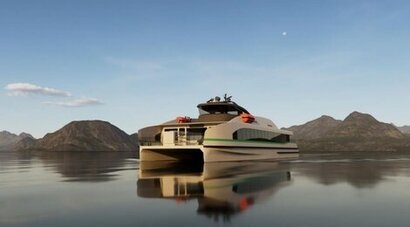
Equipped to carry around 150 passengers, the catamaran vessel will be 31 metres long with a nine-metre beam. It will be equipped with two electric motors and a 1.5 MWh capacity battery with charging power of more than 2 MW. This will be the world’s first fully electric and zero-emission fast ferry classed in accordance with the International Code of Safety for High-Speed Crafts (HSC Code). As the TrAM project’s demonstrator vessel, it will begin a trial passenger service between the city of Stavanger and surrounding communities and islands in spring 2022 to test and validate the project findings. The vessel has been designed for a service speed of 23 knots and has been named Medstraum (literally ‘with electricity’ and ‘co-current‘ in Norwegian).
The TrAM project was initiated by industry cluster organisation NCE Maritime CleanTech and is being coordinated by Kolumbus, the independent mobility services arm of Rogaland County Council.
The zero-emission aspect is the main driver for Kolumbus as part of its ongoing efforts to reduce the footprint of its public transport assets. Rogaland County Council has itself committed 6.8 million euros in co-funding for the vessel.
“TrAM’s overall aim is to develop new modular methods for the design and production of zero-emission fast ferries for inshore passenger transport, in order to reduce investment costs and delivery time” said project manager Mikal Dahle of Kolumbus.
Rogaland County mayor Marianne Chesak added that Rogaland County Council has a strategy to drastically lower emissions for all ferry routes and that the TrAM project showcases what is possible for future public transport – with no noise or emissions to the environment.
The TrAM project scope also includes the development of two further ‘replicator’ vessels, one for passenger operations on the River Thames in London and the other for deployment on inland waterways in Belgium.
The project partners have worked hard to optimise the design of the Medstraum and the hydrodynamic performance of the hull. Both the hull and superstructure will be built in aluminium, which in addition to low weight for lower energy consumption contributes to the circular economy as it is easy to recycle.
TrAM is also revolutionary in terms of simplified design and manufacturing of the future vessels, drawing on Fraunhofer IEM’s experiences in modular production techniques from the car and aviation industries. Using advanced modularisation, the project aims to lower production costs and engineering hours for electric fast ferries by 25 percent and 70 percent, respectively, which will significantly enhance their competitiveness.
Simply put, modularisation is a design-phase concept for handling internal complexity while allowing for external variety. Modular architecture enables individual modules to be combined so that subsequent vessels can be adapted to specific customer requirements. Reusing modules also allows for faster development and production.
For additional information:

